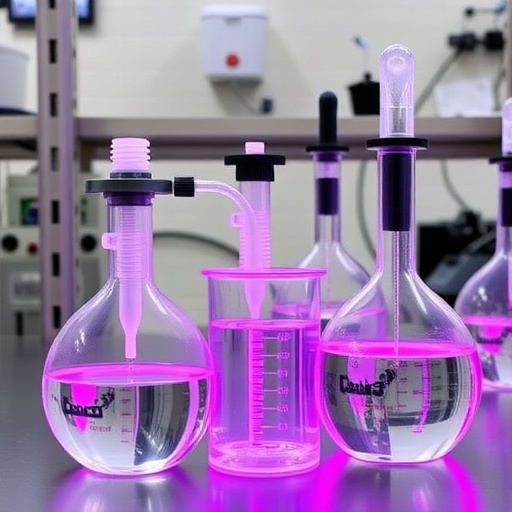In a groundbreaking leap for synthetic chemistry, a team of scientists has unveiled a novel strategy harnessing energy transfer to achieve enantioselective photocyclization mediated by an aluminum-salen (Al–salen) catalyst. This pioneering work, recently published in Nature Chemistry, represents a paradigm shift in the way chemists can manipulate light-induced reactions with exquisite control over stereochemistry, heralding new possibilities in the synthesis of complex, chiral molecules pivotal to pharmaceuticals and materials science.
Photocyclization reactions — where light energy induces the formation of cyclic molecular structures — have long fascinated chemists for their ability to create architecturally complex frameworks. Yet, achieving enantioselectivity, the preferential formation of one chiral isomer over another, remains an enduring challenge. Traditional photo-induced reactions often lack the directional control necessary to favor one enantiomer, limiting their utility in medicinal chemistry where the three-dimensional arrangement of atoms dictates biological activity.
The innovation by Soika, Onneken, Wiegmann, and colleagues leverages a unique Al–salen complex that acts as a ‘privileged catalyst’—a term reserved for catalysts exhibiting broad efficiency and selectivity across a wide array of substrates. By ingeniously integrating energy transfer mechanisms into this catalytic platform, the researchers orchestrate a photocyclization process that not only proceeds under mild conditions but does so with remarkable enantioselective precision.
Central to this breakthrough is the coupling of photophysical phenomena with chiral catalysis. The Al–salen catalyst absorbs visible light, entering an excited state capable of transferring energy selectively to the substrate. This interaction prompts cyclization while the chiral environment imparted by the ligand framework biases the reaction pathway towards one enantiomer. Unlike classical photocatalysis which often relies on electron transfer mechanisms, this energy transfer approach sidesteps competing redox processes, minimizing side reactions and improving overall yield and selectivity.
The mechanistic insight garnered from spectroscopic and computational studies sheds light on the delicate interplay between catalyst excitation, energy migration, and substrate activation. The team employed transient absorption spectroscopy to capture short-lived excited states, confirming the efficient energy relay between catalyst and reactant. Complementary quantum chemical calculations detailed the potential energy surfaces, rationalizing the observed stereochemical outcomes by illustrating the steric and electronic effects within the catalyst-substrate complex.
Notably, the approach is versatile, accommodating a variety of substrates with different functional groups and electronic properties. This adaptability underscores the concept of the Al–salen catalyst as a privileged scaffold, capable of inducing stereocontrol across disparate molecular architectures. The methodology’s compatibility with visible light also bodes well for sustainable chemistry, offering a low-energy alternative to traditional thermal cyclization reactions which often require harsh reagents and conditions.
The implications for synthetic organic chemistry are profound. By demonstrating the controlled use of energy transfer within enantioselective photochemical transformations, this work paves the way for novel reaction design strategies. The ability to harness light in a stereoselective fashion opens new avenues for assembling chiral molecules, which are otherwise difficult or cumbersome to synthesize via classical methods.
Beyond synthetic utility, this development resonates with broader trends in green chemistry. Utilizing photons as traceless reagents reduces chemical waste and energy consumption, aligning with principles of atom economy and environmental stewardship. The catalytic system’s operational simplicity—ambient temperatures, visible light irradiation, and catalytic rather than stoichiometric amounts—improves its appeal for large-scale applications, including pharmaceutical manufacturing where enantiopurity is strictly mandated.
This accomplishment also invites inquiry into the design principles of photocatalysts. The success of the Al–salen framework suggests that integrating robust chiral ligands with photoactive metal centers can yield catalysts that elegantly combine photophysical and stereochemical functions. It encourages chemists to explore other metal-ligand combinations capable of mediating energy transfer with chiral induction, hinting at a new class of multifunctional catalytic systems.
Furthermore, this catalyst’s dual role as both chromophore and chiral director reflects a sophisticated level of molecular engineering. It highlights the power of ligand design to modulate not only the electronic properties of metal centers but also the spatial environment during excited-state reactions. Consequently, the interface between inorganic coordination chemistry and photophysics stands out as a fertile ground for innovation in asymmetric catalysis.
The research also underscores the importance of interdisciplinary collaboration. Advancing such complex photocatalytic systems required seamless integration of synthetic chemistry, spectroscopy, computational modeling, and mechanistic analysis. This collective effort exemplifies how modern chemical discoveries arise at the intersection of multiple specialties, advancing the frontiers of molecular science.
Looking forward, the potential to adapt this energy transfer-enabled, enantioselective photocyclization to more intricate natural product syntheses or the creation of functional materials is alluring. The modularity of the catalyst system could permit fine-tuning for particular substrates or reaction conditions, facilitating access to a wider array of chiral molecules previously inaccessible or economically unfeasible to produce.
Importantly, this approach may inspire novel photochemical strategies beyond cyclization reactions. The fundamental concept of using chiral catalysts to mediate enantioselective energy transfer could be generalized to other transformations involving radicals or excited intermediates, broadening the toolbox available to synthetic chemists.
In conclusion, the work by Soika et al. marks a milestone in asymmetric photocatalysis. By harnessing the unique properties of Al–salen catalysts to mediate enantioselective photocyclization through energy transfer, the study presents a sophisticated yet practical method to create chiral cyclic molecules with high precision. This strategy not only expands the horizons of photocatalytic reaction design but also aligns with sustainable and efficient synthesis paradigms, poised to catalyze further advances in both academic research and industrial applications.
As synthetic methodologies continue to evolve, the fusion of light-driven processes with chiral catalysis stands to revolutionize how chemists construct molecular complexity. The promise of this energy transfer-enabled photocyclization system is a beacon for future exploration, inviting the scientific community to envision new ways in which the subtle dance of photons and catalysts can be choreographed to build life-changing molecules.
Subject of Research: Enantioselective photocyclization enabled by energy transfer catalysis using an aluminum-salen complex.
Article Title: Energy transfer-enabled enantioselective photocyclization using a privileged Al–salen catalyst.
Article References:
Soika, J., Onneken, C., Wiegmann, T. et al. Energy transfer-enabled enantioselective photocyclization using a privileged Al–salen catalyst. Nat. Chem. (2025). https://doi.org/10.1038/s41557-025-01857-1
Image Credits: AI Generated




